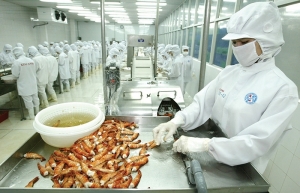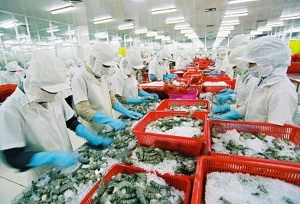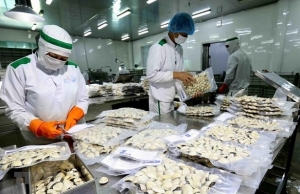Seafood producers eye record profit yet face mounting challenges
Vinh Hoan Corporation (VHC), one of the top producers and exporters of basa fish in the country, raked in more than $34.2 million in the second quarter of this year, triple compared to one year ago, setting a record since the company came on the bourse in the fourth quarter of 2007.
This means VHC has fulfilled nearly 84 per cent of the year's profit plan just after six months.
Similarly, Sao Ta Food JSC also eyed a record quarterly profit since going on the bourse in the fourth quarter of 2006.
Along with this, the company counted more than $5.13 million in post-tax profit in Q2, showing a 30 per cent jump on-year.
 |
| The seafood sector reaped $6.7 billion in total export value in the first seven months, showing a 35 per cent jump on-year |
IDI Development and Investment Corporation reaped nearly $100 million in Q2, up 8.5-fold on-year, reaching its highest profit level since its first disclosure of information to the public in the first quarter of 2010.
Nam Viet JSC saw its post-tax profit soaring 10-fold to exceed $104.3 million in Q2, setting a record since the first quarter of 2019.
Minh Phu Seafood Corporation deemed Vietnam’s largest shrimp exporter, earned more than $8.52 million in post-tax profit during the period, up 2.5-fold on-year based on the parent company’s separate financial report.
The producers have attributed their accelerated profits to high export prices and favourable export business.
Domestically, in early August the price of basa fish picked up 30 per cent compared to one year ago, or the price of white shrimp was pegged at about $10 per kg, much higher compared to one year ago.
In the export market, in the first seven months of this year, the seafood sector reaped $6.7 billion in total export value, equal to a 35 per cent jump on-year. Of which, exports of basa fish brought in $1.62 billion, equal to a 78.8 per cent jump on-year.
Despite such impressive business results, industry experts assumed that mounting hardships await seafood businesses in the months ahead.
| According to VASEP, rising production costs increased the prices of many seafood items, thus lowering the products’ competitiveness. |
At a meeting of the prime minister with the business community on August 11, Nguyen Hoai Nam, vice secretary of the Vietnam Association of Seafood Exporters and Procedures (VASEP), noted that escalating inflation in many countries has moved their residents to reduce consumption. Consequently, many importers reported not receiving further orders until October.
According to VASEP, rising production costs increased the prices of many seafood items, thus lowering the products’ competitiveness.
About a 20 per cent hike in aquafeed price post-pandemic has significantly pushed up the production cost as the aquafeed price for basa fish and shrimp accounts for about 65-70 per cent of the production cost.
 | More to come from exports in seafood Seafood exporters surprised in 2021 with a turnover of $8.9 billion, up 6 per cent compared to 2020, but experts and government officials recommend further diversifying targeted export markets and making good use of existing trade agreements. |
 | Seafood export showing falling sign in August In August, seafood exports to all markets decreased by 16-50 per cent compared to the same period in 2020. |
 | Action urged to lighten the load for seafood groups The seafood sector is clamouring for further governmental support as production costs skyrocket in the face of extra testing and safety measures. |
Moreover, shipping and manpower costs, as well as other input expenses such as packaging and chemicals are all increasing. Particularly, the cost of compliance with environmental standards poses a challenge to many producers.
“The seafood sector’s two important phases, farming and processing, are impeded due to environmental violations. For instance, many current criteria for shrimp and fish farming are found not suitable for actual farming practice, such as the standards applied to organic phosphate treatment in frozen seafood processing,” noted the VASEP report. "So we expect the Ministry of Natural Resources and Environment to consider devising a specific set of standards applicable for the sector."
What the stars mean:
★ Poor ★ ★ Promising ★★★ Good ★★★★ Very good ★★★★★ Exceptional
Related Contents
Latest News
More News
- Tax sector wraps up 2025 and sets priorities for next year (December 25, 2025 | 14:00)
- A tipping point for digital and hybrid wealth management in Vietnam (December 23, 2025 | 13:33)
- $250 million deal targets women-owned SMEs, sustainable agriculture (December 22, 2025 | 17:40)
- Stock market posts resilient 2025 performance (December 19, 2025 | 18:17)
- Citi Vietnam receives 2025 AmCham CSR recognition (December 19, 2025 | 16:35)
- As global green supply chain reshapes, will Vietnam be left behind? (December 19, 2025 | 08:00)
- Banks gear up for massive capital increases (December 18, 2025 | 17:04)
- Securing capital and efficiency for Vietnam’s 2026-2030 growth ambitions (December 17, 2025 | 10:00)
- Energy sector in need of blended finance mechanisms (December 17, 2025 | 09:00)
- Vietnam still has room to mobilise capital for sustainable growth (December 17, 2025 | 08:57)

 Tag:
Tag:



























 Mobile Version
Mobile Version